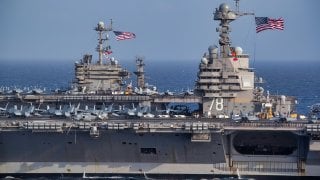There Are Now 3 U.S. Aircraft Carriers in the Western Pacific
The deployment will send a strong message to China.
The U.S. Navy continues to be spread thin, and throughout much of the late summer and fall, there was an absence of an American aircraft carrier in the Indo-Pacific. It was the first time since 2001 that the U.S. 7th Fleet was without a carrier.
However, this week, due to a potentially volatile situation, there are now three Nimitz-class nuclear-powered flattops operating in the region.
The United States is Supporting Taiwan
The presence of the three carriers comes as Taiwanese Presiden Lai Ching-te made a weekend visit to Hawaii. During this time, he met with the Aloha State’s Governor, Josh Green, and spoke by phone with former Speaker of the House Nancy Pelosi (D-Calif.), as well as other U.S. lawmakers.
Beijing was quick to condemn the visit.
“The Taiwan question is at the core of China's core interests, and the first red line that cannot be crossed in China-U.S. relations,” Chinese Ministry of Foreign Affairs spokesperson Lin Jian said in a press conference on Monday.
Countering China's Saber Rattling
Beijing has acted aggressively during past interactions between Taipei and Washington, and that has included increasingly large-scale military exercises. The U.S. Navy's trio carrier deployment is clearly meant to send a message to temper any saber rattling.
USS Abraham Lincoln (CVN-72) recently departed CENTCOM and the 5th Fleet Area of Responsibility, which is now reported to be operating in the Western Pacific. The fifth Nimitz-class supercarrier is four and a half months into her current deployment—and will likely spend the upcoming holidays in the region.
Just last week CVN-72 made its second scheduled port call of her 2024 deployment when she arrived at Port Klang, Malaysia. It was the first time a U.S. Navy aircraft carrier has visited the Maritime Southeast Asian nation since 2012, and also the first since the now infamous “Fat Leonard” Francis scandal unfolded.
CVN-72 won't be the only U.S. Navy flattop that will ring in the New Year on the other side of the world.
USS George Washington (CVN-73) arrived last month at Yokosuka, Japan, and completed her homeport change—becoming the U.S. Navy's only forward-deployed aircraft carrier. The warship completed her midlife refueling and complex overhaul (RCOH) last year—but returned to service more than two years later than expected.
However, CVN-73 is now the first forward-deployed carrier to operate with an F-35C Lightning II squadron—and only the third of the Nimitz class to be able to operate with an Advanced Air Wing.
Third Carrier On the Way
USS Carl Vinson (CVN-71), the fourth Nimitz-class nuclear-powered carrier, departed San Diego on November 18 for a previously unannounced deployment to the 7th Fleet Area of Responsibility.
The presence of CVN-71 and her carrier strike group (CSG) will also send a strong message. As Naval News reported, “The Carl Vinson's embarked Carrier Air Wing 2 (CVW-2) is the Navy's first confirmed operator of the AIM-174B ALC, the longest range air-to-air missile in U.S. inventory,” and added, “CVW-2 is the most technologically advanced air wing in the U.S. Navy today.”
Author Experience and Expertise: Peter Suciu
Peter Suciu is a Michigan-based writer. He has contributed to more than four dozen magazines, newspapers, and websites, with over 3,200 published pieces and over a twenty-year career in journalism. He regularly writes about military hardware, firearms history, cybersecurity, politics, and international affairs. Peter is also a Contributing Writer for Forbes and Clearance Jobs. You can follow him on Twitter: @PeterSuciu. You can email the author: [email protected].
Image Credit: Creative Commons and/or Shutterstock.

